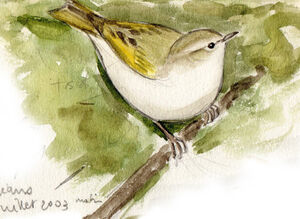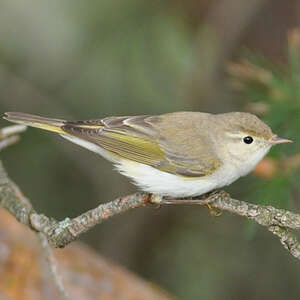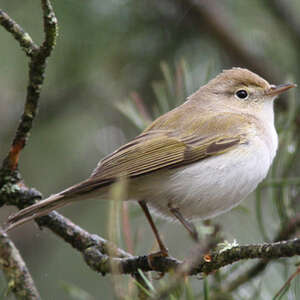Western Bonelli's Warbler
Phylloscopus bonelli - Pouillot de Bonelli
Identification
The Western Bonelli's Warbler stands out from its many and close relatives by its practically white chest and belly and the much more subtle olive-green on the back and wings. The yellow-green however is still visible on the edges of the remiges and rectrices as well as on the rump. The eyebrow is little or not visible and almost white.
Subspecific information monotypic species
Foreign names
- Pouillot de Bonelli,
- Mosquitero papialbo,
- felosa-de-papo-branco,
- Berglaubsänger,
- Bonelli-füzike,
- Bergfluiter,
- Luì bianco,
- bergsångare,
- Eikesanger,
- kolibiarik horský,
- budníček západní,
- Bjergløvsanger,
- vuoriuunilintu,
- mosquiter pàl·lid,
- Limsöngvari,
- świstunka górska,
- Bonellī ķauķītis,
- hribska listnica,
- Светлобрюхая пеночка,
- ボネリームシクイ,
- 博氏柳莺,
- bergsångare,
- 西方博尼氏柳鶯,
Voice song and call
The song is a short and powerful trill, quicker and more edited than that of the European Chiffchaff. The call is a good identification criterion because it is typical and frequently delivered, especially when the bird is uneasy: these are two clearly distinct syllables Piou-uii. The first is sharp and the second is rising, like a question.
Habitat
Behaviour character trait
The Western Bonelli's Warbler gives the impression of being even livelier and more alert than its chiffchaff and Dunnock cousins. It is constantly moving around in the vegetation and rarely appears out in the open. It often makes short stationary flights, similar to a hummingbird, in order to catch its food.
This warbler is migratory and leaves Europe between August and the end of September to go to Sub-Saharan and West Africa. It returns in April.
Reproduction nesting
The female builds a spherical nest made of dry vegetation, directly on the ground, generally in a hillside, at the foot of a bush or a shrub.
The nest is not lined with feathers unlike the ones of the Common Chiffchaff or the Willow Warbler. The female lays 5 or 6 eggs which she incubates alone for 13 days. After about twelve days of feeding in the nest by the female and, more randomly, by the male, the chicks take flight. At this stage, each parent generally takes care of half of the clutch to continue providing food outside of the nest.Geographic range
Threats - protection
IUCN conservation status
concern
in the Wild
threatened
evaluated
Sources of information
- IOC World Bird List (v15.1), Gill, F and D Donsker (Eds). 2025-12-07.
- Les passereaux d'Europe, tome 2, P. Géroudet, M. Cuisin
- Les Oiseaux d'Europe, d'Afrique du Nord et du Moyen-Orient, Lars Jonsson
- Les Oiseaux d'Europe et d'Afrique du Nord, Hermann Heinzel, Richard Fitter, John Parslow
- Birds of the World, The Cornell Lab of Ornithology
- xeno-canto, Sharing bird sounds from around the world,
Other sources of interest
 Specification sheet created on
02/08/2023 by Renan Levaillant
Specification sheet created on
02/08/2023 by Renan LevaillantTranslation by AI Oiseaux.net
© 1996-2026 Oiseaux.net
- Accipitriformes
- Aegotheliformes
- Anseriformes
- Apodiformes
- Apterygiformes
- Bucerotiformes
- Caprimulgiformes
- Cariamiformes
- Casuariiformes
- Charadriiformes
- Ciconiiformes
- Coliiformes
- Columbiformes
- Coraciiformes
- Cuculiformes
- Eurypygiformes
- Falconiformes
- Galliformes
- Gaviiformes
- Gruiformes
- Leptosomiformes
- Mesitornithiformes
- Musophagiformes
- Nyctibiiformes
- Opisthocomiformes
- Otidiformes
- Passeriformes
- Pelecaniformes
- Phaethontiformes
- Phoenicopteriformes
- Piciformes
- Podargiformes
- Podicipediformes
- Procellariiformes
- Psittaciformes
- Pterocliformes
- Rheiformes
- Sphenisciformes
- Steatornithiformes
- Strigiformes
- Struthioniformes
- Suliformes
- Tinamiformes
- Trogoniformes





























